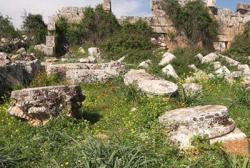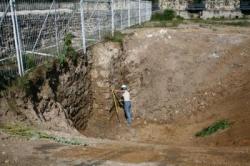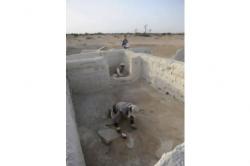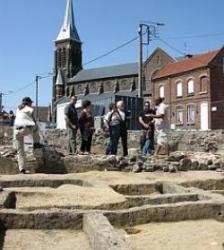- 24 MAI
- SYRIE -  Deir Sinbol - Deir Sinbol Site is one of the most prominent archeological spots in the Idleb, north Syria, for the diversity of its architectural design which is clearly reflected in its unique buildings. The site, dating back to the Byzantine Era, contains a number of intact tombs, palaces, lodgings, 'Bazlik' church, presses, a tower, wells and tanks. The buildings of the village are characterized with the carved inscriptions and drawings. "Deir" means a place of worship or monastery and "Sembol" means welfare and goodness so the whole meaning becomes Goodness Monastery, according to historians. Head of Idleb Antiquities Department Nicola Kabbad said Deir Sinbol Village is a paradigm for what is called a 'residential city'. It contains well designed streets and villas, the most famous of which is 'Facile Lamb Villa'. The villa was named after the inscription of a lamb holding a cross sign on its back. Head of Excavation Section Anas Zedan said that the village's church lies between Facile Lamb Villa and al-Afandi Palace, adding that the church is in ruinsbecause of a strong earthquake that hit the area in the past, yet it is characterized with its large size.
Deir Sinbol - Deir Sinbol Site is one of the most prominent archeological spots in the Idleb, north Syria, for the diversity of its architectural design which is clearly reflected in its unique buildings. The site, dating back to the Byzantine Era, contains a number of intact tombs, palaces, lodgings, 'Bazlik' church, presses, a tower, wells and tanks. The buildings of the village are characterized with the carved inscriptions and drawings. "Deir" means a place of worship or monastery and "Sembol" means welfare and goodness so the whole meaning becomes Goodness Monastery, according to historians. Head of Idleb Antiquities Department Nicola Kabbad said Deir Sinbol Village is a paradigm for what is called a 'residential city'. It contains well designed streets and villas, the most famous of which is 'Facile Lamb Villa'. The villa was named after the inscription of a lamb holding a cross sign on its back. Head of Excavation Section Anas Zedan said that the village's church lies between Facile Lamb Villa and al-Afandi Palace, adding that the church is in ruinsbecause of a strong earthquake that hit the area in the past, yet it is characterized with its large size.
http://sana.sy/eng/35/2011/05/21/348088.htm
- FRANCE –  Nègrepelisse - Dans le cadre de la future création du centre d'art La Cuisine, des fouilles archéologiques sont entreprises par l'Inrap, Institut national de recherches archéologiques préventives, depuis quelques jours et jusqu'au au mois de septembre, avec de légères interruptions durant cet été. Il s'agit de la quatrième et dernière campagne de fouilles qui devrait se solder par une publication scientifique des résultats obtenus. Cinq secteurs seront fouillés: la salle basse du corps de logis nord du château avec son escalier d'accès et les tours d'angle nord-est et nord-ouest, la cour du château et ses maçonneries périphériques, la tour-porte (donjon), la face ouest de la courtine ouest et l'esplanade (place des Platanes), plus précisément l'emplacement des futurs réseaux enterrés. Selon les sondages déjà réalisés, les archéologues devraient trouver des couches archéologiques datant du Moyen âge et certifiant la date de construction de l'édifice.
Nègrepelisse - Dans le cadre de la future création du centre d'art La Cuisine, des fouilles archéologiques sont entreprises par l'Inrap, Institut national de recherches archéologiques préventives, depuis quelques jours et jusqu'au au mois de septembre, avec de légères interruptions durant cet été. Il s'agit de la quatrième et dernière campagne de fouilles qui devrait se solder par une publication scientifique des résultats obtenus. Cinq secteurs seront fouillés: la salle basse du corps de logis nord du château avec son escalier d'accès et les tours d'angle nord-est et nord-ouest, la cour du château et ses maçonneries périphériques, la tour-porte (donjon), la face ouest de la courtine ouest et l'esplanade (place des Platanes), plus précisément l'emplacement des futurs réseaux enterrés. Selon les sondages déjà réalisés, les archéologues devraient trouver des couches archéologiques datant du Moyen âge et certifiant la date de construction de l'édifice.
http://www.ladepeche.fr/article/2011/05/24/1089294-negrepelisse-au-chateau-les-fouilles-ont-debute.html
- ABU DHABI –  Al Ain - Heritage experts are using laser technology to document an ancient site in Al Ain that dates back to the Iron Age. The site, Hili-17, includes three excavated mud huts and is said to date to about 1,000BC. The laser survey has built a detailed digital model of the huts on the north-western side of Hili garden. The method involved exposing surfaces to a laser beam to create three-dimensional images. The method was chosen so surveyors can be more precise when coding the bent walls and irregular surfaces of the mud structures. Also, due to the fragility of the structures, a laser allows for minimum contact between the surveyor and the construction model. More than 100 pieces were surveyed in total, resulting in more than 3,000 digital images. The photos will be added to three-dimensional models the team has created, allowing them to better map out their recording and restoration efforts. It has been suggested Hili-17 was once an industrial centre, because researchers have found stoves they believe were used to produce pottery. The buildings, which underwent the excavations in the early 1990s, have not received the necessary protection from the elements and have degraded significantly over the past 20 years. Rain, wind and sand storms have led to the decay, and in some cases collapse, of their fragile mud walls of dirt.
Al Ain - Heritage experts are using laser technology to document an ancient site in Al Ain that dates back to the Iron Age. The site, Hili-17, includes three excavated mud huts and is said to date to about 1,000BC. The laser survey has built a detailed digital model of the huts on the north-western side of Hili garden. The method involved exposing surfaces to a laser beam to create three-dimensional images. The method was chosen so surveyors can be more precise when coding the bent walls and irregular surfaces of the mud structures. Also, due to the fragility of the structures, a laser allows for minimum contact between the surveyor and the construction model. More than 100 pieces were surveyed in total, resulting in more than 3,000 digital images. The photos will be added to three-dimensional models the team has created, allowing them to better map out their recording and restoration efforts. It has been suggested Hili-17 was once an industrial centre, because researchers have found stoves they believe were used to produce pottery. The buildings, which underwent the excavations in the early 1990s, have not received the necessary protection from the elements and have degraded significantly over the past 20 years. Rain, wind and sand storms have led to the decay, and in some cases collapse, of their fragile mud walls of dirt.
http://www.thenational.ae/featured-content/latest/lasers-make-light-work-of-mapping-iron-age-site
- FRANCE –  Dechy - Les pelleteuses ont disparu du chantier archéologique lancé juste en face de la mairie ... de Dechy et à côté de l'église. Là, sur une surface de quasiment 8 000 m², les archéologues mettent manuellement au jour un habitat de type carolingien, mais pas seulement. La présence de quelques niveaux de sol (des bases d'habitat en pierre destinées au support de murs en bois) date de l'époque du haut Moyen Âge. Guidés par ces premiers indices et d'autres petits objets (manche de couteau en os ouvragé, fusaïole, palets de jeux retaillés dans de la tuile ou morceaux de céramiques...), les archéologues ont six mois pour en apprendre plus sur la transformation séculaire de cette modeste exploitation agricole - construite en bois -, avec ses fosses et trous de poteaux, en la commune d'aujourd'hui. La partie carolingienne coïncide avec la première mention historique de Dechy, cité sur un diplôme de Charles le Chauve. À Dechy, d'autres chantiers sont en effet en cours et concernent la même période historique. Ils sont situés dans les rues Victor-Hugo, Gambetta et Maurice-Richard.
Dechy - Les pelleteuses ont disparu du chantier archéologique lancé juste en face de la mairie ... de Dechy et à côté de l'église. Là, sur une surface de quasiment 8 000 m², les archéologues mettent manuellement au jour un habitat de type carolingien, mais pas seulement. La présence de quelques niveaux de sol (des bases d'habitat en pierre destinées au support de murs en bois) date de l'époque du haut Moyen Âge. Guidés par ces premiers indices et d'autres petits objets (manche de couteau en os ouvragé, fusaïole, palets de jeux retaillés dans de la tuile ou morceaux de céramiques...), les archéologues ont six mois pour en apprendre plus sur la transformation séculaire de cette modeste exploitation agricole - construite en bois -, avec ses fosses et trous de poteaux, en la commune d'aujourd'hui. La partie carolingienne coïncide avec la première mention historique de Dechy, cité sur un diplôme de Charles le Chauve. À Dechy, d'autres chantiers sont en effet en cours et concernent la même période historique. Ils sont situés dans les rues Victor-Hugo, Gambetta et Maurice-Richard.
http://www.lavoixdunord.fr/Locales/Douai/actualite/Secteur_Douai/2011/05/24/article_les-archeologues-mettent-au-jour-une-fer.shtml
- SRI LANKA –Trincomalee - The Department of Archaeology has initiated action to recognize the Trincomalee old harbour (Black Bay) and the Trincomalee Fort as world heritage buildings. The Director General of Archaeology, Dr Senerath Bandara Dissanayake said the proposal would be forwarded to the UNESCO shortly.
http://print.dailymirror.lk/news/provincial-news/44835.html
- USA –Danger Cave – Jukebox Cave - Utah's Danger and Jukebox caves are remarkable archaeological sites for several reasons. Both provided shelter for ancient groups of people as far back as 12,000 years ago and have clues hidden in the strata that tell valuable stories to research teams. Danger Cave — once known as Hands and Knees Cave because the curious had to crawl in to access it — is considered the cornerstone of archaeological research in the Great Basin. Jukebox Cave — Indian Cave or Picture Cave — contains rock artwork of hunters on horses armed with spears and bows and arrows that is fascinating and unique. Today it also has a concrete dance floor that once lent itself to parties for soldiers and their dates. And remarkably, the two hillside caves remain intact enough to warrant further study and protection despite periodic years of abandonment during which looters and relic hunters paraded through the precious sites with abandon. Protective iron bar gates were put up in 1998. The research has given historians a rough timeline of the occupants: Paleoindian (8,000-12,000 years ago), Desert Archaic people (2,000-8,000 years ago) an, the Fremont and Anasazi Indians (700-2,000 years ago), followed by the late prehistoric tribes, the Spanish explorers and finally the pioneers in 1847. And now, DNA experts can examine the quids and determine which tribal people occupied the caves, where the people came from and their migration patterns.
http://www.deseretnews.com/article/705373187/Danger-Jukebox-caves-offer-valued-insights-into-Utahs-past.html?pg=2
- INDE – Mysore - Even as Mysore Grahakara Parishat (MGP) has called for the preservation and interpretation of artifacts found while sprucing up the Niranjana Mutt on Narayana Shastri Road, the Archaeology Department remains ignorant of the historical remains there. Niranjana Mutt is undergoing restoration works undertaken by the local authorities since the building is in ruins. Prior to that, Chief Minister B.S. Yeddyurappa had allotted Rs. 5 crore to erect a monument commemorating the visit of Swami Vivekananda here in 1892. Swami Vivekananda had stayed here as a guest of Chamaraja Wadiyar, prior to his visit to Chicago and the famous address at the Parliament of World Religions. Vasanthkumar Mysoremath of MGP has demanded the exploration and preservation of historical remains found while removing the debris, piled up for decades in the Mutt premises. According to Mysoremath, two carved pedestals were seen with brick walls and kadappa stone floorings while removing the debris near the eastern gate. Abutting this was an area having some kind of foundation and it could be the mogasaale of the temple, he said. Some sculptured stone pillars as well as about one foot thick slabs have been seen lying around without proper preservation or maintenance. In one slab, one can see some sort of carved designs, which can be explained by the Archaeology experts, Mysoremath observed.
http://www.starofmysore.com/main.asp?type=news&item=28432